
Originally published in The Clarinet 51/3 (June 2024).
Copies of The Clarinet are available for ICA members.
Book and Music Reviews:
June 2024
BOOKS
Mike Vaccaro. Music and Life: Thoughts on Music, Phrasing, Woodwinds and This Modern World. ADC Media, 2023. Kindle: $9.99; paperback: $18.41
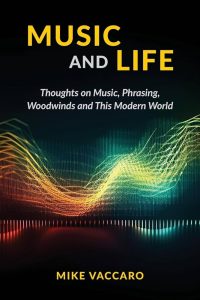 Mike Vaccaro is a multiple woodwind player (clarinets, saxophones, flute) who has performed with the Stan Kenton Orchestra and on numerous recordings and film scores, including the Pixar movie, Ratatouille. In addition to his work as a performing artist, his 60-year career also includes work in music production, contracting, and other aspects of the music business. This book is written in a comfortably informal style, as a caring teacher might speak with a student. It blends practical woodwind-specific information with real-world experience and ideas that can only come from someone who has worked for many years as a professional woodwind player. The author also offers philosophies and observations about life as a musician that I found both encouraging and actionable because Vaccaro arrived at them through his own experiences, as well as observations of others over the course of his very long career.
Mike Vaccaro is a multiple woodwind player (clarinets, saxophones, flute) who has performed with the Stan Kenton Orchestra and on numerous recordings and film scores, including the Pixar movie, Ratatouille. In addition to his work as a performing artist, his 60-year career also includes work in music production, contracting, and other aspects of the music business. This book is written in a comfortably informal style, as a caring teacher might speak with a student. It blends practical woodwind-specific information with real-world experience and ideas that can only come from someone who has worked for many years as a professional woodwind player. The author also offers philosophies and observations about life as a musician that I found both encouraging and actionable because Vaccaro arrived at them through his own experiences, as well as observations of others over the course of his very long career.
The book is divided into four parts: Music, Teaching, Woodwinds, and Money; Ezines (electronic magazines); A Broader Look at Life’s Problems, and Quotes and Thoughts. Within these four parts are concise, easy-to-read chapters. The author encourages the reader to take notes in the margins of the book, which I agree with, particularly for aspiring players, because it may help them focus their energies as their careers develop. A few of his philosophies I found myself writing in the margins were, “success is getting what you want,” and “happiness is wanting what you get,” and “we become what we practice on a daily basis.” Vaccaro also gives some very specific ideas regarding playing and practicing, such as a thorough discussion of instrument position, along with the excellent suggestion of developing a listening schedule, in addition to a practice schedule, something that not all teachers focus on. I wholeheartedly agree with his approach to being a multiple woodwind player: “study an instrument privately from an outstanding teacher.”
The colloquial writing style sometimes veers off to thoughts that are loosely related to the chapter title, but I found that refreshing because, as stated earlier, it is similar to how a caring teacher might talk with a student. I do not think everyone will agree with all the thoughts and philosophies in the book, but I recommend it as a helpful resource, particularly for a young woodwind player seeking to become a professional musician. After reading this book, I found myself going back to chapters that resonated with my own experiences, which then made me want to go practice. I found that a very nice outcome of spending time with this book!
– John Cipolla
Thomas Grass and Dietrich Demus. Das Bassetthorn: Entwicklung, Instrumente und Musik. Volume three. Edited and published by Grass/Demus, 2023. Purchase at: BoD Bookshop: €46.60
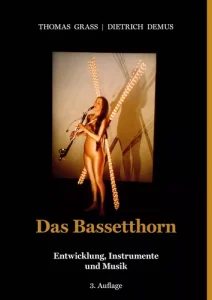 The basset horn is without a doubt one of the most fascinating instruments of the large clarinet family. It has a register which is not too low and not too high, hence the name of bassetto (bassetto referenced the cello in 19th-century Germany). “Horn” reflects the original sickle shape of the first instruments, resembling the natural horn, built in the mid-18th century by the Mayrhofer brothers of Passau (in the southern part of Germany). The basset horn had its acme in the classical period thanks to Mozart who used it in a good number of his compositions: Five Divertimentos, K. 439 (or 25 Terzettos), Six Notturni with voices, Gran Partita, K. 361, Requiem, K. 626, and the obligato part from the opera La clemenza di Tito, to cite the most important. In Bohemia it was also held in high regard, having virtuoso players who could play and develop the repertoire for this beautiful instrument.
The basset horn is without a doubt one of the most fascinating instruments of the large clarinet family. It has a register which is not too low and not too high, hence the name of bassetto (bassetto referenced the cello in 19th-century Germany). “Horn” reflects the original sickle shape of the first instruments, resembling the natural horn, built in the mid-18th century by the Mayrhofer brothers of Passau (in the southern part of Germany). The basset horn had its acme in the classical period thanks to Mozart who used it in a good number of his compositions: Five Divertimentos, K. 439 (or 25 Terzettos), Six Notturni with voices, Gran Partita, K. 361, Requiem, K. 626, and the obligato part from the opera La clemenza di Tito, to cite the most important. In Bohemia it was also held in high regard, having virtuoso players who could play and develop the repertoire for this beautiful instrument.
Unfortunately, the basset horn became obsolete in the 19th century with the rise of the bass clarinet. Richard Strauss used it in some of his operas, and in the contemporary era Karlheinz Stockhausen wrote a large number of works, dedicating them to Suzanne Stephens. Thomas Grass and Dietrich Demus started their incredible research on the basset horn two decades ago and published the first volume of their book in 2002 and the second in 2004, and the third volume has just been published last year. This recent 419-page(!) book is a significant addendum to the other two volumes and has ten chapters, each one having many different subjects covering all possible information about this instrument! We can discover important things about modern makers, use of the basset horn in all possible contexts, the development of its repertoire, other bass instruments of the clarinet family, composers and virtuosi from its entire history, and lists with detailed descriptions of surviving basset horns, all capped off with a large bibliography. Complementing the text are photographs of historical (some peculiar) and contemporary basset horns. This is a huge and wonderful work (considered with the other two books of the same authors) that has no equal with other scholarship. There are no words to describe such a monumental, detailed, scrupulous, and amazing publication about this instrument! What a shame that, at the moment, the book is available only in German.
– Luigi Magistrelli
MUSIC
David Vining. The Big Book of Sight Reading Duets for clarinet. Edited by Andrew Seigel. Mountain Peak Music, 2022. $24.95
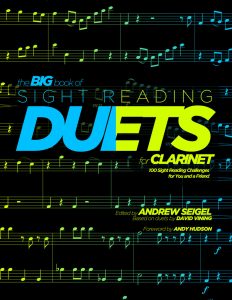 Through his Mountain Peak Music publishing house offerings, trombonist, educator, and composer David Vining advocates for health, wellness, and good instrument technique. The Big Book of Sight Reading Duets is part of that mission and is available in separate compatible editions for clarinet, flute, oboe, or bassoon so that musicians playing any two of these instruments could sight read together. The volume for clarinet gives both clarinet parts on each page. The instrument range throughout these progressively ordered one-page sight-reading duets is modest. This points to their use also for advancing bass clarinetists; in fact, one duet includes a low C—that many a bass clarinetist could play!
Through his Mountain Peak Music publishing house offerings, trombonist, educator, and composer David Vining advocates for health, wellness, and good instrument technique. The Big Book of Sight Reading Duets is part of that mission and is available in separate compatible editions for clarinet, flute, oboe, or bassoon so that musicians playing any two of these instruments could sight read together. The volume for clarinet gives both clarinet parts on each page. The instrument range throughout these progressively ordered one-page sight-reading duets is modest. This points to their use also for advancing bass clarinetists; in fact, one duet includes a low C—that many a bass clarinetist could play!
With a sturdy spiral binding, the 100 pages of duets are complemented with ten preliminary hand-clapping rhythm-only duets, a six-page introduction with helpful suggestions to develop one’s sight reading skills, and contributions by two distinguished clarinet professors: Andrew Seigel’s motivating preface, and a foreword by Andy Hudson. There is a good variety of key signatures, meters, rhythmic patterns, and tempos. The one- and two-word titles are in appealing vernacular, and I think that every teacher and student will be intrigued to see what is on the next page, and the page after… in other words, these duets are a motivating resource to practice sight reading.
– Gregory Barrett
David Edwards. Minibeasts for clarinet and piano. United Music Publishing Ltd., 2022. £28.99/$36.50 www.ump.co.uk.
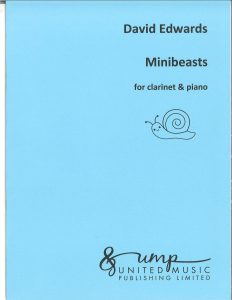 David Edwards is a British organist who has worked as a music teacher for over 30 years, specializing in choral and instrumental ensembles, and who has a knack for composing satisfying works for maturing performers. Minibeasts, his five-movement work for clarinet and piano, is his contribution to our canon.
David Edwards is a British organist who has worked as a music teacher for over 30 years, specializing in choral and instrumental ensembles, and who has a knack for composing satisfying works for maturing performers. Minibeasts, his five-movement work for clarinet and piano, is his contribution to our canon.
These charming little pieces—accompanied by a happy little snail on the front cover—accurately evoke the titular beasts with some clever musical settings. The first movement, “Mayflies,” is a short, playful ABA setting with a bouncy, clarion-register opening and a slower chalumeau middle section for contrast. These pieces are short, and this one has a few tricky ascending altissimo slurs that demand a little attention. Movement two, “The Snail’s Journey,” is a low-register tune that gently plods along—as the composer describes it, “Lugubrious, and with great effort!” This movement has a gentle harmonic language and is perfect for younger players who are still confined to the chalumeau.
As to be expected, “To Bee, or not to Bee,” the third movement, is flitty and in 16th notes. It is in an accessible key of B-flat concert with a manageable quarter = 92 tempo. It does not venture into the altissimo, so it is well-suited to a cross-section of performers. “Dragonflies” is a gentle, flowing 6/8 designed to get students comfortable playing in compound meters. The last movement, Garden Worm, is similar in tempo and tessitura to “The Snail’s Journey.” Edwards does not give descriptors to every piece, but his description in the piano part nails the slinking character of the piece: “The clarinet is the beneficial worm, moving underneath to aerate the soil.”
Minibeasts is a useful supplement to our library for a variety of reasons. This is a musically satisfying original piece written specifically for clarinet, designed for an intermediate player accumulating technique on the verge of performing our more iconic works. The keys are friendly, the movements are short, the harmonic language is a gentle chromaticism easy on the ears, and the slower movements are playable by less experienced performers. The piano part is friendly with a few unexpected chromatic moments. Edwards’ experience as an Examiner for the London College of Music informed his choices to make a musically satisfying and charming work that fills a necessary place for developing students and teachers looking for a fun new piece.
– Osiris Molina
Alexandre Carlin. Epic Variants for bass clarinet and concert band. Also available for bass clarinet and piano. Molenaar Edition, 2023. Score: €26.16, complete set of parts: €130.80
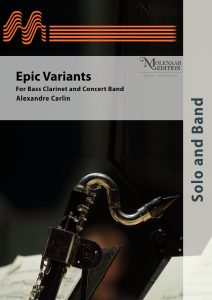 This is a welcome new work for bass clarinet solo and wind band. The work was premiered in 2022 by Didier Pernoit, bass clarinet soloist of the Orchestre Philharmonique de Radio-France, with the concert band conducted by the composer himself. The piece is through-composed and is divided into three different sections; fast-slow-fast, with the thematic material stated at the beginning repeated in variation form throughout. At just over seven minutes, it’s a nice length to fit into a mixed concert program. The solo part is fun and is a good work-out, using traditional, idiomatic material. The band parts are considerably less difficult, with rich harmonic support for the soloist.
This is a welcome new work for bass clarinet solo and wind band. The work was premiered in 2022 by Didier Pernoit, bass clarinet soloist of the Orchestre Philharmonique de Radio-France, with the concert band conducted by the composer himself. The piece is through-composed and is divided into three different sections; fast-slow-fast, with the thematic material stated at the beginning repeated in variation form throughout. At just over seven minutes, it’s a nice length to fit into a mixed concert program. The solo part is fun and is a good work-out, using traditional, idiomatic material. The band parts are considerably less difficult, with rich harmonic support for the soloist.
The work uses the whole register of the bass clarinet, from low C to high F, with the option of playing it on a low E-flat instrument if required, as the lowest pitches only appear in one bar (although a key moment in the piece) that can be played an octave higher. There is a very nice recording of this work played by soloist Filipa Gomes and the Portuguese Air Force Band that I enjoyed listening to, with a very nice balance between the soloist and the band through careful and sensitive microphone placement. I do wonder how this piece would work in a live situation, as the band accompaniment is strong. I imagine it would be best to amplify the bass clarinet soloist to achieve a nice blend.
The composer was a member of the French National Police Band and is clearly passionate about wind bands, having composed more than 200 works for this medium.
– Paul Roe
Igor Stravinsky. Three Pieces. Arranged for three clarinets by Gregory M. Barrett. Theodore Presser, 2023. $24.99
 Northern Illinois University clarinet professor Gregory Barrett has arranged Stravinsky’s Three Pieces for Solo Clarinet (1918) for three clarinets, and the myriad benefits the new arrangement brings to the pedagogy and performance of this foundational unaccompanied clarinet work should not be underestimated.
Northern Illinois University clarinet professor Gregory Barrett has arranged Stravinsky’s Three Pieces for Solo Clarinet (1918) for three clarinets, and the myriad benefits the new arrangement brings to the pedagogy and performance of this foundational unaccompanied clarinet work should not be underestimated.
For performers and audiences, the new arrangement provides a fresh and fun perspective on a standard work. The original is present in its entirety, yet Barrett parses its phrases and motives, assigning them equal weight between the arrangement’s three clarinets. Those accustomed to performing the original solo will need to recalibrate their attention to avoid missing frequent hand-offs. Of course, this element of danger adds potential excitement to the performance, and the counterpoint itself shimmers under the added tension.
Barrett’s arrangement proposes a well-considered analysis and interpretation of the original, and his “Arranger’s Notes” outline clear justifications for the harmonic choices he makes. Examples include the emphasized C-sharp as the (initially concealed) dominant of F-sharp minor in the first movement, the major sevenths and seconds contrasting with triadic harmonies in the second movement, and emphasized quartal harmonies and stacked fourths in the third movement. The textural elements of each movement vary according to the character of the original: sustained harmonies in the first movement, imitation in the second, and driving homophony in the third. Barrett’s notes also suggest subtle imagery to accompany each of the movements, whether the sun emerges to dispel gloom, trapeze artists perform acrobatic feats beneath the big top, or three “characters” reveal distinctive personalities within a ragtime burlesque. Both the aural implications of the arrangement and its associated imagery provide clear waypoints for students of the original, who all too often find themselves disoriented within the ineluctable murmuring and meandering of Stravinsky’s melodies.
– Matthew Nelson
Carlos Pavan. Two Pieces, Rhapsody & Fantasia for clarinet and guitar. Alry Publications, 2021. $20.00 6 minutes.
_____. Malambo Connotations for flute, clarinet, and guitar. Guitar Chamber Music Press, 2023. $15.00 5 minutes.
_____. Brooklyn Folk Divertimento for woodwind quintet. Alry Publications, 2022. $25.00 5 ½ minutes.
These three works by composer and guitarist Carlos Pavan reflect his expertise in music of his native Argentina. They are appealing for audience and performer and are very much in the mainstream of combining folk music with formal elements and instrumentation of classical music.
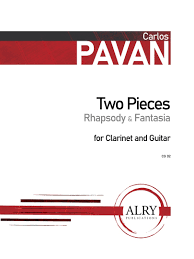 Two Pieces, Rhapsody & Fantasia for clarinet and guitar, like the other two works, is of medium difficulty. The Rhapsody begins with a slow expressive solo for the clarinet. The traditional guitar arpeggiation that joins is the underpinning for the bulk of this flowing, expressive gem. Fantasia is enlivened by faster moving notes and prominent guitar chords of propulsive mild dissonances. The movement-ending thrice-repeated chord in clarinet and guitar is built of five stacked perfect fourths plus one augmented fourth.
Two Pieces, Rhapsody & Fantasia for clarinet and guitar, like the other two works, is of medium difficulty. The Rhapsody begins with a slow expressive solo for the clarinet. The traditional guitar arpeggiation that joins is the underpinning for the bulk of this flowing, expressive gem. Fantasia is enlivened by faster moving notes and prominent guitar chords of propulsive mild dissonances. The movement-ending thrice-repeated chord in clarinet and guitar is built of five stacked perfect fourths plus one augmented fourth.
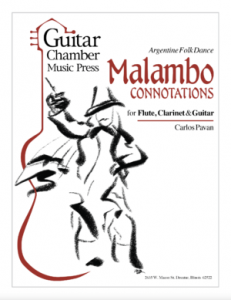 Malambo Connotations was developed from a solo guitar malambo dance piece by Hector Ayala. Pavan’s setting with flute, clarinet, and guitar allows each instrument to lead in the fast, yet lilting, 6/8 meter. The melody is clearly presented, and the scoring is lean, with no fussy counterpoint. Notable is the eight-measure “percussion fantasy” where all players are instructed to perform the dance rhythm with only key clicks and tapping.
Malambo Connotations was developed from a solo guitar malambo dance piece by Hector Ayala. Pavan’s setting with flute, clarinet, and guitar allows each instrument to lead in the fast, yet lilting, 6/8 meter. The melody is clearly presented, and the scoring is lean, with no fussy counterpoint. Notable is the eight-measure “percussion fantasy” where all players are instructed to perform the dance rhythm with only key clicks and tapping.

The woodwind quintet Brooklyn Folk Divertimento has a similar non-pitched percussive excursion that points to the importance of hybrid tango/folk/danza rhythm in this very energetic one-movement minor-key romp. Well-scored for each instrument, in additive fashion horn and then clarinet follow the bassoon’s lower register introductory ostinato. Plenty of syncopation is used in the 12/8 meter. The clarinet and horn each have idiomatic two-measure solos, and midway through the divertimento a slower, very soft, misterioso section is presented: flute, oboe, and clarinet each have measure-long pitch falls, the horn is muted, and the oboe forecasts the key clicks still to come for the entire group. This is a popular-sounding, entertaining work that is over all too soon.
– Gregory Barrett
Johann J. D. Stiehl. Trio, op. 2 for clarinet, viola, and piano. Edition Clarinova, Trio Musik, 2023. €24.80 https://triomusic.de.
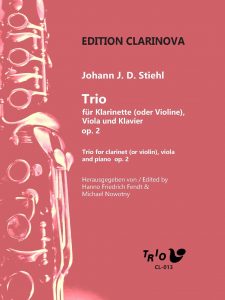 Here is a new and interesting publication from Edition Clarinova. The repertoire for clarinet, viola, and piano is not as rich as the one for clarinet, cello, and piano or other chamber music clarinet combinations, but we have a few gems such as Schumann’s Märchenerzählungen and the eight Bruch pieces, not to mention Mozart’s “Kegelstatt” Trio, K. 498, which is a true masterpiece without equal. Mozart was the first composer to put together these instruments, as was also the case for the wonderful Quintet, K. 452, for piano and winds. Johann J. D. Stiehl (1800-1873) is to all clarinet players (including me) a completely unknown composer. He was a prominent musician in the musical life of Lübeck. He studied organ and harmony with M. A. Bauck, becoming his successor as organist at Saint Jacob’s church. He was also an orchestral clarinetist. He produced three clarinet works, preserved at the Lübeck city library: Trio, op. 2, Concertino, op. 3 with large orchestra as accompaniment, and some clarinet duos without opus number. This Trio was intended for clarinet with an additional violin part provided in the first edition, exactly like the Mozart Trio K. 498.
Here is a new and interesting publication from Edition Clarinova. The repertoire for clarinet, viola, and piano is not as rich as the one for clarinet, cello, and piano or other chamber music clarinet combinations, but we have a few gems such as Schumann’s Märchenerzählungen and the eight Bruch pieces, not to mention Mozart’s “Kegelstatt” Trio, K. 498, which is a true masterpiece without equal. Mozart was the first composer to put together these instruments, as was also the case for the wonderful Quintet, K. 452, for piano and winds. Johann J. D. Stiehl (1800-1873) is to all clarinet players (including me) a completely unknown composer. He was a prominent musician in the musical life of Lübeck. He studied organ and harmony with M. A. Bauck, becoming his successor as organist at Saint Jacob’s church. He was also an orchestral clarinetist. He produced three clarinet works, preserved at the Lübeck city library: Trio, op. 2, Concertino, op. 3 with large orchestra as accompaniment, and some clarinet duos without opus number. This Trio was intended for clarinet with an additional violin part provided in the first edition, exactly like the Mozart Trio K. 498.
The viola is an ideal stringed instrument, with the right color to match the clarinet. The quality of this trio is high, with a technically demanding piano part, and beautiful melodies for the clarinet and viola. The style is a good representation of the classical period, of which Mozart was unequaled. Editors Hanno Fendt and Michael Nowotny did a fine job relying on the first edition published by August Cranz. The name of “Monsieur M. Ruesch” is written on the title page of the first edition as the dedicatee. This Trio is a precious discovery, and I have recently made a recording of it.
– Luigi Magistrelli
Claude Debussy. Première Rhapsodie and Petite Pièce. Arranged by Nicolai Pfeffer for solo clarinet, flute, harp, and string quartet. Edition Clarinova, Trio Musik, 2023. €38.00 https://triomusic.de.
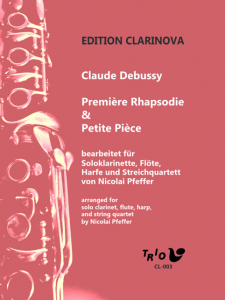 Nicolai Pfeffer is already known for other fine arrangements published by Edition Clarinova, Henle, and Breitkopf. The Première Rhapsodie of Debussy is a milestone for every clarinet player, a real masterpiece of modern times, and not just of the French repertoire. Debussy conceived this piece, like other clarinet compositions by great masters (Mozart, Brahms, Reger, Schubert, Saint-Saëns) in the late period of his life. The Paris Conservatoire commissioned this piece in 1910 as a solo de concours, in the French tradition. In the same year Debussy composed the short, charming Petite Pièce to be used as sight reading in the final exams of the clarinetists. The Première Rhapsodie is dedicated to Prospère Mimart (1859-1928), who was the professor of clarinet at the Paris Conservatoire from 1904 until 1918. Mimart gave the premiere performance on January 16, 1911.
Nicolai Pfeffer is already known for other fine arrangements published by Edition Clarinova, Henle, and Breitkopf. The Première Rhapsodie of Debussy is a milestone for every clarinet player, a real masterpiece of modern times, and not just of the French repertoire. Debussy conceived this piece, like other clarinet compositions by great masters (Mozart, Brahms, Reger, Schubert, Saint-Saëns) in the late period of his life. The Paris Conservatoire commissioned this piece in 1910 as a solo de concours, in the French tradition. In the same year Debussy composed the short, charming Petite Pièce to be used as sight reading in the final exams of the clarinetists. The Première Rhapsodie is dedicated to Prospère Mimart (1859-1928), who was the professor of clarinet at the Paris Conservatoire from 1904 until 1918. Mimart gave the premiere performance on January 16, 1911.
This composition is recognized today as one of the most important solo works for the clarinet. Debussy was so satisfied that in 1911 he orchestrated the piano part so that the piece could be performed by soloist with orchestra. Debussy’s scoring uses a large orchestra, so this new fine arrangement for chamber ensemble of Nicolai Pfeffer is most welcome. It includes colors and appropriate impressionistic effects required for this piece. Pfeffer followed the model of Ravel’s Introduction and Allegro by using the same instrumentation; and did so again for the Petite Pièce. It would be ideal to perform the two pieces together. Bravo, Mr. Pfeffer, for these important and precious arrangements!
– Luigi Magistrelli
Denis Betro. Tapestry for Clarinets. Forton Music, 2023. Digital: £10.50, print: £14.00
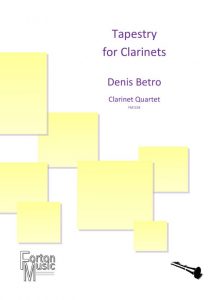 What a treat to have a clarinet quartet written by the electrifying composer Denis Betro! Betro originates from New Zealand and lives in the United Kingdom where he came to study music at the Royal College of Music. With his immense musical talent, Betro supported himself for years by playing music in the streets of London. He wrote several expressive pieces during his travels that started out as improvisation. An acclaimed composer today, his oeuvre exhibits originality, expressivity, and invigorating atmosphere.
What a treat to have a clarinet quartet written by the electrifying composer Denis Betro! Betro originates from New Zealand and lives in the United Kingdom where he came to study music at the Royal College of Music. With his immense musical talent, Betro supported himself for years by playing music in the streets of London. He wrote several expressive pieces during his travels that started out as improvisation. An acclaimed composer today, his oeuvre exhibits originality, expressivity, and invigorating atmosphere.
Tapestry for Clarinets is an upbeat, beautiful, and short work for clarinet quartet with E-flat, B-flat, and bass clarinets. The piece may first appear easier than it is because its melodic and rhythmic materials hint towards minimalism in some places. However, this “simplicity” can be deceiving as there are accidentals, precise rhythm, and ensemble balance to be mastered when playing it.
The quartet would work well for medium to advanced clarinet quartets, including in high schools and colleges. Its relative brevity would make it ideal for focusing on the style and musical elements. While the quartet is not fully minimalist in style, it features combinations of small rhythmic and melodic cells that often reach across bar lines. Maintaining mental focus on these motifs, while also performing within the full musical context, makes excellent preparation for playing fully minimalist music.
Betro says in the introduction to Tapestry for Clarinets: “The various contrapuntal lines in this piece weave in, out, and across each other in what I have termed a musical tapestry. A lot of unwinding and unfurling occurs which results in a satisfactory and homogenous experience.” This also addresses the delightful chamber music experience this quartet offers. In many places, there is a light polyphonic texture where all parts are equal, while in others there is a more homophonic setting in which two or more parts are trading tunes and the remaining parts have complementary roles. These roles change frequently and as a result, chamber music aficionados, students, and teachers will be immersed in listening to this web of melodies that is always active and lively.
To finish, a quote from Betro’s website says it well, “Using a vivid rhythmic idiom and a tonal approach ensures that the music is accessible and enjoyable for a contemporary audience.”
– Barbara Heilmair
Subito Music Publishing has submitted five works by American composer James Cohn (1928–2021) for review in The Clarinet. Cohn was a prolific composer whose accolades included the Queen Elizabeth of Belgium prize and an AIDEM prize. Major orchestras commissioned him to write works, the Detroit Symphony among them, and his compositions have been performed in prestigious venues throughout the world. His composition teachers included Roy Harris, Wayne Barlow, and Bernard Wagenaar, and he graduated from Juilliard’s composition program in 1950. His generosity toward the clarinet extends beyond the scores listed below to two clarinet concerti, a clarinet sonata with piano, duos with violin, guitar, and a second clarinet, wind quintets, a klezmer fantasy, and several works for clarinet choir. Cohn’s clarinet works have received numerous performances and recordings: Jon Manasse recorded both of his clarinet concerti on the XLNT label, and the late Guido Six collaborated with Cohn on clarinet choir commissions and premieres. Fittingly, ClarinetFest® 2022 featured a James Cohn tribute concert given by Sarah Korneisel-Jaegers and Vanessa Klassen.
James Cohn. Three Dances op. 87 (2005), for clarinet and guitar. Subito Music Publishing. $25.95
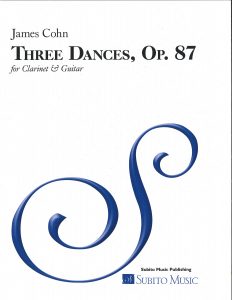 Cohn composed Three Dances for Raphael Sanders and David Galvez. Its three distinctive movements are titled “Old Russian Dance” (clarinet in A), “Old Mountaineer’s Dance” (clarinet in B-flat), and “Viva Mexico!” (clarinet in B-flat), and derive from folk melodies such as Jarabe Tapatío. These fun and straightforward dances possess lively counterpoint and traditional harmony, providing easy access for any audience. Cohn requires that the clarinetist be able to play with facility to altissimo G with quick articulation throughout, but these dances are not beyond the reach of an advanced high school player. The second movement seems to contain an error in the score: it specifies “Clarinet in B-flat” on the first system but proceeds to list “E-flat Cl.” in the systems thereafter. The harmonies in the guitar part and the clarinet key signature would indicate B-flat clarinet throughout.
Cohn composed Three Dances for Raphael Sanders and David Galvez. Its three distinctive movements are titled “Old Russian Dance” (clarinet in A), “Old Mountaineer’s Dance” (clarinet in B-flat), and “Viva Mexico!” (clarinet in B-flat), and derive from folk melodies such as Jarabe Tapatío. These fun and straightforward dances possess lively counterpoint and traditional harmony, providing easy access for any audience. Cohn requires that the clarinetist be able to play with facility to altissimo G with quick articulation throughout, but these dances are not beyond the reach of an advanced high school player. The second movement seems to contain an error in the score: it specifies “Clarinet in B-flat” on the first system but proceeds to list “E-flat Cl.” in the systems thereafter. The harmonies in the guitar part and the clarinet key signature would indicate B-flat clarinet throughout.
James Cohn. Three Pieces for Clarinet (1999). Subito Music Publishing. $10.95
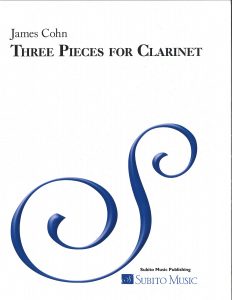 Cohn’s Three Pieces for Clarinet seems a popular choice amongst clarinetists, boasting numerous YouTube recordings and featuring in the aforementioned ClarinetFest® 2022 tribute concert to Cohn. Samford University Clarinet Professor Brian Viliunas even offers a choreographed version. Its popularity should come as no surprise, as the exciting motivic bursts and driving rhythmic energy in the first movement, “Wind Song,” immediately engage the listener. Unlike the Three Dances above, Cohn’s Three Pieces for Clarinet represents a more serious endeavor, requiring brilliant technique to traverse the frequent and rapid intervallic leaps in its first movement. “Slow Dance,” the second movement, relies on a scheme of syncopated accents and sudden dynamic shifts to sculpt a sultry atmosphere full of arrogance and suspense. The final “Polonaise” begins with an Apollonian pentatonic theme into which Cohn progressively infuses jazzy material, providing a comic struggle over its three pages.
Cohn’s Three Pieces for Clarinet seems a popular choice amongst clarinetists, boasting numerous YouTube recordings and featuring in the aforementioned ClarinetFest® 2022 tribute concert to Cohn. Samford University Clarinet Professor Brian Viliunas even offers a choreographed version. Its popularity should come as no surprise, as the exciting motivic bursts and driving rhythmic energy in the first movement, “Wind Song,” immediately engage the listener. Unlike the Three Dances above, Cohn’s Three Pieces for Clarinet represents a more serious endeavor, requiring brilliant technique to traverse the frequent and rapid intervallic leaps in its first movement. “Slow Dance,” the second movement, relies on a scheme of syncopated accents and sudden dynamic shifts to sculpt a sultry atmosphere full of arrogance and suspense. The final “Polonaise” begins with an Apollonian pentatonic theme into which Cohn progressively infuses jazzy material, providing a comic struggle over its three pages.
James Cohn. Trio No. 2 (2013), for clarinet, cello and piano. Subito Music Publishing. $12.95
James Cohn. Variations on a Boogie-Woogie (2016), for clarinet in A, cello, and piano. Subito Music Publishing. $15.95
Cohn’s two short one-movement trios, Trio No. 2 and Variations on a Boogie-Woogie, offer charming snapshots of his lucid and accessible style. Each lasts under three minutes, and either might serve as an effective encore.
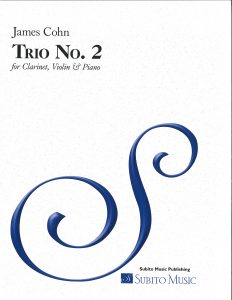 Trio No. 2 resides firmly in D minor, passing its opening theme between the three instruments before fragmenting and becoming more contrapuntal. Cohn demands only modest technique in this sketch, and it would be appropriate for a wide range of performers. The scores for both trios give the clarinet parts in C (individual parts were not sent by the publisher, but one would trust that they have been transposed), confounding the increasingly common practice of performing from the score. Additionally, Trio No. 2 causes some initial confusion by listing clarinet, violin, and piano on its cover and title page, though the score itself includes only clarinet, cello, and piano.
Trio No. 2 resides firmly in D minor, passing its opening theme between the three instruments before fragmenting and becoming more contrapuntal. Cohn demands only modest technique in this sketch, and it would be appropriate for a wide range of performers. The scores for both trios give the clarinet parts in C (individual parts were not sent by the publisher, but one would trust that they have been transposed), confounding the increasingly common practice of performing from the score. Additionally, Trio No. 2 causes some initial confusion by listing clarinet, violin, and piano on its cover and title page, though the score itself includes only clarinet, cello, and piano.
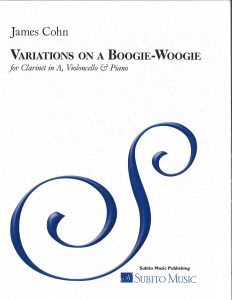 Variations on a Boogie-Woogie begins with a fun jazzy theme in 12/8 that moves through a section in straight 4/4 and a waltz in 3/4 before returning to the 4/4 “boogie-woogie.” Regardless of whether the 12/8 would have been more readable as “swung” 4/4, the performer must overcome some counterintuitive notation in places where the software (or the engraver) conflated rhythmic values that would have been more readable in tied beat groups. One other quibble: the transition from 12/8 to 4/4 in the second section of the piece gives no indication of any metric modulation or tempo shift. Does the beat stay the same, or the eighth note? Without more information, an argument could be made either way. Nevertheless, these variations provide several minutes of easy entertainment for any audience.
Variations on a Boogie-Woogie begins with a fun jazzy theme in 12/8 that moves through a section in straight 4/4 and a waltz in 3/4 before returning to the 4/4 “boogie-woogie.” Regardless of whether the 12/8 would have been more readable as “swung” 4/4, the performer must overcome some counterintuitive notation in places where the software (or the engraver) conflated rhythmic values that would have been more readable in tied beat groups. One other quibble: the transition from 12/8 to 4/4 in the second section of the piece gives no indication of any metric modulation or tempo shift. Does the beat stay the same, or the eighth note? Without more information, an argument could be made either way. Nevertheless, these variations provide several minutes of easy entertainment for any audience.
James Cohn. Diaspora, Op. 101 (2009), for 2 clarinets, violin, cello, and piano. Subito Music Publishing. $26.95
 Cohn’s Diaspora draws upon Jewish folk themes over the course of its six minutes, outlining three distinctive melodic sections: an opening D minor, a middle B-flat major in a contrasting meter, and a final section that begins in C minor and works its way to a triumphant D major triad to end the piece. Cohn made considerable use of Jewish musical material throughout his career, particularly in his Symphony No. 4 and Variations on the Wayfaring Stranger, as noted by a Spring 2019 profile in B’nai B’rith Magazine. The combination of two clarinets, violin, cello, and piano creates a uniquely dialogic texture, in which Cohn is as likely to use like voices as a homophonic color as he is to engage them in imitative counterpoint. Beyond this, the three contrasting instrumental groups, clarinet, strings, and piano, create a full and varied soundscape. Unlike the two trios above, Diaspora’s score transposes the B-flat clarinet parts.
Cohn’s Diaspora draws upon Jewish folk themes over the course of its six minutes, outlining three distinctive melodic sections: an opening D minor, a middle B-flat major in a contrasting meter, and a final section that begins in C minor and works its way to a triumphant D major triad to end the piece. Cohn made considerable use of Jewish musical material throughout his career, particularly in his Symphony No. 4 and Variations on the Wayfaring Stranger, as noted by a Spring 2019 profile in B’nai B’rith Magazine. The combination of two clarinets, violin, cello, and piano creates a uniquely dialogic texture, in which Cohn is as likely to use like voices as a homophonic color as he is to engage them in imitative counterpoint. Beyond this, the three contrasting instrumental groups, clarinet, strings, and piano, create a full and varied soundscape. Unlike the two trios above, Diaspora’s score transposes the B-flat clarinet parts.
– Matthew Nelson
Comments are closed.